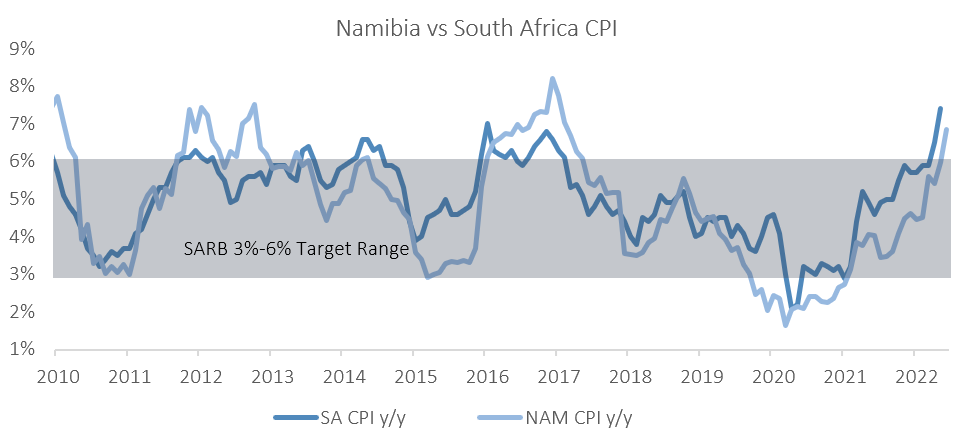
Namibia’s annual inflation rate slowed marginally to 7.1% y/y in September from 7.3% y/y in August. Prices in the overall NCPI basket rose by 0.1% m/m. On a year-on-year basis, overall prices in nine of the twelve basket categories rose at a quicker rate in September than in August, two recorded a slower rate of inflation and one recorded prices consistent with August. Prices for goods increased by 9.8% y/y, while prices for services increased by 3.3% y/y.

Predictably, the transport category was the largest contributor to the annual inflation rate in September, contributing 2.8 percentage points to the annual inflation rate. The category recorded a price decline of 1.6% m/m, but transport prices are still 19.5% higher than a year ago. Two of the three sub-categories recorded slower inflation on a month-on-month basis with the operation of personal transport equipment sub-category recording a decrease of 2.1% m/m, but an increase of 30.0% y/y, on the back of the Ministry of Mines and Energy’s decision to decrease fuel prices at the beginning of September. Petrol prices were cut by 120 cents per litre and diesel prices by 65 cents per litre. Petrol prices were cut by a further 100 cents per litre in the beginning of October, however given that most of the economy operates on diesel (which did not see a change in price this time round), we expect inflationary pressure to persist. The purchase of vehicles sub-category recorded a decrease in inflation of 0.9% m/m, but rose 3.2% y/y. Prices of public transportation services remained steady on a month-on-month basis, but rose 6.4% y/y.

Food & non-alcoholic beverages was the second biggest contributor to the annual inflation rate in September, contributing 1.7 percentage points. Overall, prices in this basket item rose 0.6% m/m and 9.3% y/y, the quickest year-on-year increase since February 2017. All thirteen sub-categories in this basket item recorded price increases on an annual basis. The largest increases were recorded in the prices of oils and fats which rose by 25.5% y/y, followed by fruit which recorded an increase of 20.4% y/y, mainly attributable to the increase in prices of avocados, citrus fruits, and dried fruits.
Alcohol & tobacco inflation quickened to 5.6% y/y in September, from the 5.2% y/y increase recorded in August. On a month-on-month basis, prices of the basket category rose by 0.8%. The prices of alcohol beverages rose by 0.7% m/m and 5.8% y/y, while the prices of tobacco products increased by 1.2% m/m and 4.5% y/y.

Namibia’s annual inflation rate of 7.1% in September followed three consecutive months of quicker inflation prints and was mainly attributable to the decrease in fuel prices. The transport-, food- and alcohol and tobacco categories remain the largest contributors to inflation, accounting for 75% of the Namibian inflation rate in September, with the remaining 9 categories contributing the other 25%. South Africa’s annual inflation rate has similarly slowed in August, but at 7.6% y/y continues to trend above the SARB’s 3-6% target band and means that we will see further rate hikes by the SARB’s MPC. We expect the Bank of Namibia to reciprocate to any decisions taken by the SARB. IJG’s inflation model currently forecasts Namibia’s annual inflation rate to remain elevated for the remainder of 2022, and for it to end the year at around 7.0%.











